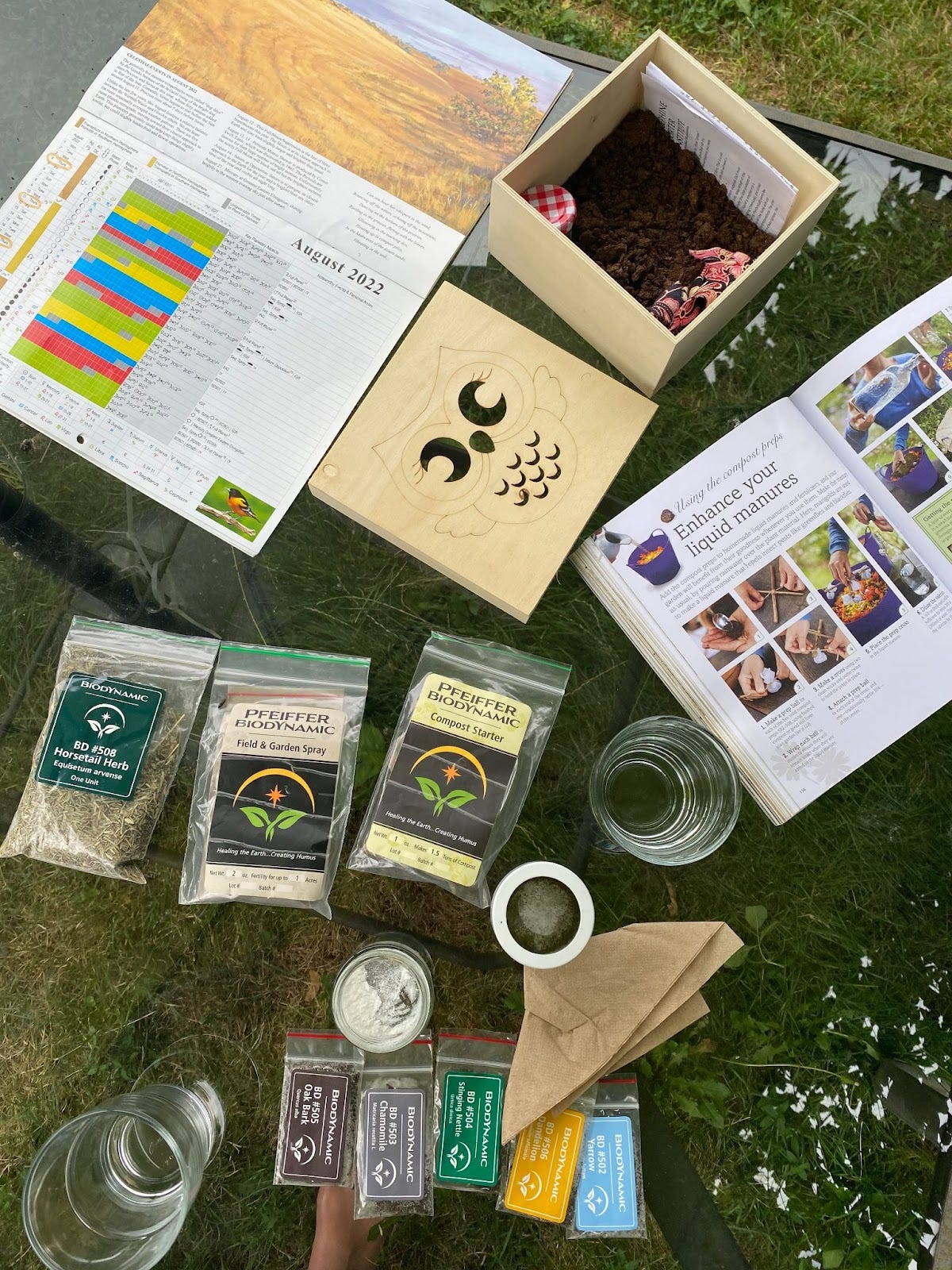Hi, I’m Kate.
I am a new monthly contributor to this most cherished living journal, joining
and who have contributed greatly to my biodynamic education through this very online offering.When I was first approached to write, I was equal parts excited and afraid.
The fear arose not for worry that I would have nothing to say (I am a writer by trade and words are the very wick of my soul), but that I would have nothing of quality to contribute. You see, I am a fervent yet largely self-taught student.
Biodynamics was introduced to me as a community offering; a gift that we humble humans can give back to the elementals that nurture and feed us.
For the past seven years, I have been studying, writing and living into Steiner’s teachings, both academically at the Rudolf Steiner College of Canada, and intrinsically through the years of Covid by joining a group of seven families learning Waldorf home education and festival work together.
During those years of isolation, we became a living ecosystem, and were taught how to stir and spray by our mentor and elder, Elyse Pomeranz.
As of now, I am an urban biodynamic gardener. I want to get better at growing delicious and healthy food, and I love creating and playing with children in teaching gardens. I hold certificates in Permaculture and Edible Food Forests, and I like my gardens like my six-year-old: wild and free.
As the Cosmic Journal expands and grows, it is inviting new voices like mine into the mix, to share practical hands-on research about biodynamic gardening in urban environments and to conduct experiments inspired by the work of unsung biodynamic heroes, both present and past.
I’ll also be writing calendar indications. Now is the time for preparation and planning. For those still at the mercy of winter, who put things away messily or who have not sorted their seeds and seedling trays, it is time to get started.
It’s seedling season. Remember, prior to planting in trays we soak our seeds in BD 500 or in BC (barrel compost). Let’s walk through the calendar.
On March 1st, the New Moon makes a slushy slide from airy, cold and dry Aquarius into the wet earthy arms of Pisces. But remember, this is New Moon water energy. Go slow. You’ll have two Leaf Days in a row to sow cold hardy leafy greens. Lettuces in particular.
On March 4th, our waxing crescent moon drifts into action-oriented Aries, and we are given the opportunity of a single Fruit Day. Fruit Days on the ascending moon are a good time to take cuttings and prune. Clean up your raspberries, gooseberries, currants, and dogwoods. Sow cucumbers and / or tomatoes indoors, depending on your last frost date. Cucumbers generally take three to four weeks before last average frost; tomatoes take longer, around six to eight weeks. Sweet peppers and chilli peppers can be started alongside your tomatoes.
By 9 pm, we enter earthy Taurus, and enjoy two late-winter ascending moon Root Days. For year-round garlic, you could plant in late winter while the promise of frost remains. You can also sow beets indoors in the late winter then transplant outside. Sow beet seeds shallowly ½ inch (1cm) deep in rows 6 inches (15cm) apart. Green onions and leeks are also ready to be started indoors.
On March 7th, the moon reaches the First Quarter and the period of inward concentration is complete. As the moon moves away from the sun, the flow of sap becomes more vigorous, and life forces begin to rise from the roots. By 12 pm, we shift from Root Day to Flower, entering the sign of Gemini. For those tapping trees such as maple and birch, these Flower Days set the syrup season off right.
From March 9th to 11th, we enjoy descending moon leaf days in Cancer, when one could start leaf plants such as cabbage, lettuce, spinach and herbs indoors, depending on the last frost date.
March 12th to 13th, the moon enters Leo, and under this descending moon influence, sowing fruit and seed crops is highly advised, depending on your last frost date. For those around 4 to 6 weeks before the risk of last frost, start pumpkins and winter squash indoors, or outdoors under cover. “An upturned glass jar creates a warmer microclimate than a cloche.”1
March 14th, we reach the Full Moon, which is also a Total Lunar Eclipse. This is known as a Blood Moon. “During a lunar eclipse, the Sun, Moon, and Earth all align so that the Earth comes in between the Moon and Sun. This means that the Earth will cast a shadow over the Moon (also known as the umbra). When the Moon is in the umbra of the Earth, the Earth casts a reddish shadow, hence the name Blood Moon.”2 Growing up, we called March’s full moon the Sugar Moon, as everyone boiled sap.
March 15th, the moon moves into Virgo and we return to the qualities of the Root Day. In the constellation of Virgo, we can work compost into the soil and spray BC.
On March 17th, the Calendar holds at Apogee. At this time, the moon is at its farthest point from Earth, so its watery influences are weakened. Plants are vulnerable and less robust. Do not garden before 12:37 pm EST.
March 19th, we move briefly into Libra and experience a short Flower Day before the moon transits to Scorpio and Spring Equinox arrives in the northern hemisphere. We can offer a BD 500 spray to the elements and welcome Spring.
We celebrate a Leaf Day Spring Equinox March 20th to 21st. There are so many ways to celebrate the Spring Equinox. Stirring and spraying BD 500 in the late afternoon is a beautiful offering. We love to plant wheat grass in pots or lined baskets indoors, which by Easter will bring our nature table to life.

March 22nd, the moon reaches its Third Quarter in Sagittarius, and the tasks of caring for fruit, cereal and nut seeds returns. We can enjoy Fruit Day productivity until the moon enters Capricorn on March 24th.
From March 24th to 26th, we embrace Root Day tasks: sowing and tending beets, carrots, potatoes, parsnips and onions, all to be started depending on your last frost date. However, by 11 am EST on March 26th, the moon returns to airy Aquarius.
On March 27th, the moon completes its cycle, returning to Aquarius for a soft and airy Flower Day, before transitioning into Pisces early on the morning of the 28th. As the moon reaches its ascending node, it is not advised to garden before 12:29 pm EST.
We welcome inward contemplation under the watery influence of Pisces, and enjoy a New Moon Leaf Day on March 29th as the monthly cycle begins again.
Spring is emblematic of all things hopeful, and I am grateful to share these monthly calendar indications with our growing international family of farmers, gardeners, artists and friends. Bringing community, connection, hopefulness and empowerment to all those reading inspires my studies.
In my next article, I’ll share what I’m learning about unsung hero Maye Bruce and how her “quick return method” continues to inspire biodynamic gardeners around the world today.
If you haven’t bought your Calendars yet, shop for biodynamic calendars here.
Not to be missed! Stewart is hosting “The Eye of the Cosmos: Viewing Soil Life Through Chromatography”, an in-person biodynamic workshop at the Josephine Porter Institute March 21st-23rd. For those unable to attend in-person, a recorded viewing is available for purchase. Full Details here.
Thank you, I look forward to learning with you all.
Sincerely,
Kate Heming Panchal
Monty Waldin. Biodynamic Gardening. First American Edition. DK Publishing, 2015.
Catherine Boeckman. The Old Farmers Almanac. “Catch the Full Blood Worm Moon: A Lunar Eclipse”, February 12 2025.








Love this! great article! So informative on so many levels! Looking forward to the next one!
Wonderful work Kate! I look forward to reading more and being inspired for more growing with the kids here at our farm and forest school :) Thank you!